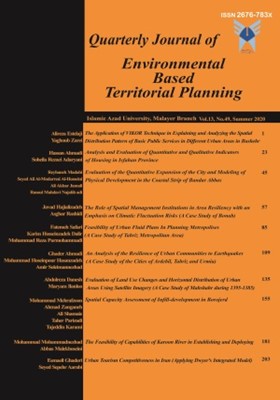Evaluation of the Quantitative Expansion of the City and Modeling of Physical Development in the Coastal Strip of Bandar Abbas
Subject Areas :
reyhaneh maddahi
1
,
seyed ali almodaresi
2
,
Ali Akbar Jamali
3
![]() ,
Rasoul Mahdavi Najafabadi
4
,
Rasoul Mahdavi Najafabadi
4
1 - PhD candidate in Geography and Urban Planning, Yazd Branch, Islamic Azad University, Yazd, Iran
2 - associate professor, remote sensing and GIS, Yazd, branch , department, Islamic Azad University , Yazd, Iran
3 - , associate professor, GIS-RS department and natural engineering, Meybod Branch, Islamic Azad University, Meybod, Iran
4 - associate professor, department of natural resources engineering, faculty of agricultural engineering and natural resources, Hormozgan University, Hormozgan, Iran
Keywords: Bandar Abbas, Logistic regression, LCM, Detection of changes, urban modeling,
Abstract :
Rapid urbanization has put heavy pressure on the land and it is surrounding resources, reducing vegetation, reducing open space and serious social and environmental problems. An important step in managing and planning urban development, as well as assessing its cumulative effects, is to study and simulate the physical development of the city. One of the processes in which a city changes can be investigated for a multi- year period and therefore predicting the directions of urban development for appropriate planning is urban development modeling, so urban designers and planners have spatial information and when they are related to urban growth patterns, they need to do the modeling. The aim of the present study is to model the urban development of Bandar Abbas city using the LCM model in the 21st year series ( 1994, 2002, 2009, 2015) using the Landsat satellite images. In the first step, after classification of images by supervised method, mostly we compared the maps with the accuracy of the KAPPA coefficient of 0.9550, and then using the land- change model to predict the map of 2021 and using the Logistic regression model and the CA-Markov chain, the development of the city in 2021 was anticipated exactly. After calculating the matrix, the probability of transfer of changes to predict land use in 2009, 2015, and 2021 was calculated using Logistic regression, which compared to land use in the years 2009 and 2015, the accuracy of the Kappa coefficient was 75.3% for 2009 and 86.9%. Also for the year 2015 we achieved relatively good results.
1- المدرسی، سید ع. هادیان، س.1395.ارزیابی فرآیدهای توسعه شهری با استفاده از روشهای پیشرفته تحلیل فضایی و تکنیک سلولهای خودکار و مقایسه با روش رگرسیون لجستیک. پایان نامه کارشناسی ارشد، رشته سنجش از دور، دانشگاه آزاد اسلامی یزد،110 صفحه.
2- انصاری،م. شریعت پناهی، م .ملک حسینی، م. مدیری، م.1396. تحلیل الگوی گسترش شهری در شهرهای میانه اندام با استفاده از مدلهای کمی(شهر ملایر). فصلنامه امایش محیط. دوره13، شماره 48. صفحه148-182.
3- رحیمی، ا. 1395. سیاستهای زمین شهری و تأثیر آن بر توسعه شهر تبریز. فصلنامه آمایش محیط. شماره 48. صفحه 109-129.
4- رحیمی، الف. 1393. مدلسازی توسعه تبریز در سال 1410 با استفاده از مدل LTM، دومین همایش ملی کاربرد پیشرفته تحلیل فضایی در آمایش سرزمین.یزد. 11-12اسفند.145-161.
5- روشن بخش، س . المدرسی، سید ع .، مدلسازی توسعه شهری همدان با استفاده از شبکه عصبی مصنوعی و رگرسیون لجستیک. پایان نامه کارشناسی ارشد، دانشگاه آزاد اسلامی یزد، 129 صفحه.
6- زارع کمالی، م . 1395. مدلسازی تغییرات کاربری اراضی با استفاده از مدل پیشبینی رگرسیون لجستیک. دومین همایش ملی کاربرد پیشرفته تحلیل فضایی در آمایش سرزمین.یزد.11-12 اسفند.98-112.
7- عزیزی قلاتی، س. 1392. مدلسازی تغییرات کاربری اراضی با استفاده از تکنیکهای سنجش از دور و سامانههای اطلاعات جغرافیایی درمنطقه کوهمره سرخی استان فارس. پایان نامه کارشناسی ارشد، دانشگاه شهید چمران اهواز.اهواز.115صفحه.
8- کامیاب، ح. 1392. کاربرد شبکه عصبی در مدلسازی توسعه شهری مطالعه موردی: گرگان، فصلنامه پژوهشهای جغرافیایی انسانی، سال سی و هشتم، شماره 68.
9- نوری نژاد، ع .ارغان، ع.1396. ارزیابی توان اکولوژیک توسعه شهری با استفاده از مدل سیستمی(شهرستان ساری). فصلنامه امایش محیط. دوره12. شماره 47.
10- Asghari zamani,A ,2007, evaluation and prediction of spatial expansion in Iranian cities case study: Zanjan city, PH.D thesis, department of Geography and urban planning in Tabriz university.
11- Fisher TR, Benetiz J A ,lee K Y, 2006, history of land cover change and biogeochemical impacts in the chop tank river basin in the mid-attlantic region of the USA ,international journal of remote sensing, 21(17):3683-3730.
12- Gómez, C.; White, J. C. & Wulder, M. A. 2011. Characterizing the state and processes of change in a dynamic forest environment using hierarchical spatio-temporal segmentation. Science of the total environment. 115(7): 1665–1679.
13- Latifovic R,Fytask, chen J, paraszczak J,2005, assessing land cover change resulting from large surface mining development, international Journal of applied earth observation and gea information,7(1):29-48.
14- Rezazade, R. Mirahmadi,M, 2009, cellular automata, a new approach in urban growth simulation, Journal of education technology,4(4).
15- Rafiee R, Salman mahiny A and khorasani N, 2009,Assessment of change detection in an urban environment, remote sens, environ, 63:95-100.
16- Tewolde M G, cabral P,2011,urban sprawl analysis and modeling in Asmara, Eritrea, remote sensing 3:2148-2165.
17- Thapa, R. B. & Murayama, Y. 2011. Urban growth modeling of Kathmandumetropolitan region, Nepal. Computers, Environment and Urban Systems. 35(1): 25–34.
18- Khoi, D.D., Murayama, Y., 2010. Forecasting Areas Vulnerable to Forest Conversion inthe Tam Dao National Park Region, Vietnam. Remote Sensing 2(5): 1249–1272.
19- Oñate-Valdivieso, F. & Sendra, J.B. 2010. Application of GIS and remote sensingtechniques in generation of land use scenarios for hydrological modeling. Journal ofHydrology. 395(3–4): 256–263.
20- Perez-Vega, A., Mas, J., Ligmann-Zielinska, A. 2012. Comparing two approaches toland use/cover change modeling and their implications for the assessment ofbiodiversity loss in a deciduous tropical forest. Environmental Modelling & Software (1): 11-23.
_||_

